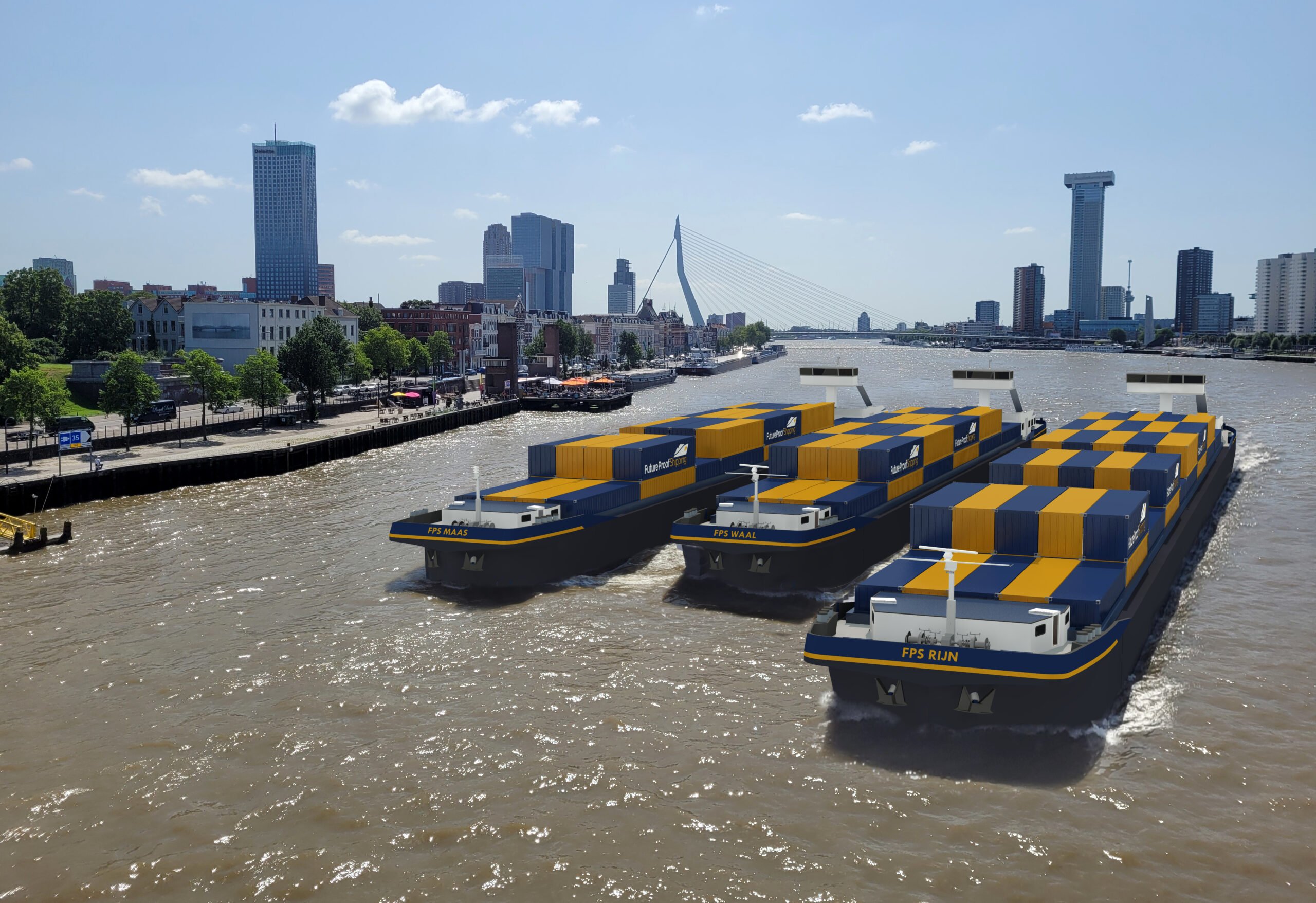
Inland shipping is switching to hydrogen. Within a year, both a converted ship – De Maas from Future Proof Shipping – as well as an entirely new vessel – the Antonie from Concordia Damen – will be sailing on this clean energy. Nevertheless, the transition process is complex. Regulations, the layout of the ship, costs and infrastructure are some of the challenges facing inland shipping.
Harm Lenten will be sailing the Antonie as the skipper, but stresses that he is an entrepreneur first and foremost. “I’ve also invested in it; I am the owner of the ship. It all started with an annual meeting of the NPRC (the largest cooperative freight forwarder active in European inland shipping, ed.), which we are a member of. When the subject came to hydrogen, I could see something in that.”
His shipping company sails to Rotterdam and back via the Delfzijl route, where salt is collected from the producer Nobiank. The production process to turn salt into chlorine releases hydrogen, which can be used effectively as a clean fuel. The tank unit for the hydrogen has yet to be built.
Hydrogen with fuel cells
The new 135-meter-long Antonie (the maximum length for inland shipping vessels) is scheduled to be completed in one year. Unlike a conventional ship, the fuel cells on this vessel convert hydrogen into electricity for propulsion. Although more and more electrically-powered vessels are already being used in inland shipping, the use of hydrogen in this process is new.
The fuel cells provide electricity to the batteries and power the propellers. A diesel generator is mandatory as a backup. It was calculated that for the Antonie, a trip back and forth consumes 1200 kilograms of hydrogen. Six exchangeable containers for cylinders at a pressure of three hundred bar are used, three of which are on board at a time.
Retro ship ‘De Maas’ should be operational in the third quarter of this year. Whereas the living quarters in the foreship on the ‘Antonie’ make way for hydrogen, the new energy system on ‘De Maas’ is installed in the cargo hold. Here, a thousand kilos of hydrogen will be released under the same pressure in two containers above the fuel cell system.
Subsidy
Both initiators cite cost as a factor that needs to be ironed out in the future. Subsidies are currently available for investment in hydrogen propulsion.
Richard Klatten of Future (CEO) says, “EC funding can definitely help projects become financially viable within the short term. But these projects will still need to develop models on which future commercial projects can operate on a larger scale. We believe new funders will step forward. Or perhaps more traditional funders will develop new models.”
“Market-based measures, such as long-term charter contracts, and operational incentives from ports, such as the provision of priority lanes and lower port fees can help improve the business case for zero-emission shipping. Regulations and standards for new propulsion technologies and alternative fuels will go a long way toward making projects profitable.”
Cooperation is important
Lenten claims that his ship is more than twice as expensive (over ten million euros). Lenten is paying half, and a large part of the remaining amount (four million euros) is covered by a government subsidy. The transition to hydrogen is still a matter of pioneering work at the moment. As yet, it is not actually profitable. Cooperation and a helping hand in the right direction are important at this time.
This is something that Femke Brenninkmeijer, CEO of the NPRC cooperative behind the Antony, also emphasizes. “It’s not just the hardware, the technology. It is especially important that a group of partners from the value chain put their shoulders into it. We are taking part in this because we are confident that it will succeed. NPRC is a commercial party; we are signing contracts with the shipping agent and the inland shipping company. To get this development underway, we need to join forces.”

Putting a puzzle together
She is referring specifically to the collaboration between the inland shipping entrepreneur, forwarder, cooperative and the government. It is precisely this approach to the chain that, according to Brenninkmeijer, will make the transition to clean hydrogen a success.
Concordia Damen can testify to that. CFO Tim van Berchum: “The strength of the Antonie project is that NPRC is responsible for coordinating, linking parties and getting that subsidy sorted out. Because it costs a lot of money to build this ship.” On the specific role as a builder: “All the technical parties have to puzzle out for themselves how the construction will take place: Koedood – the supplier of the Mitsubishi engine, the marine electrician, us with our fuel cell, you name it.”
The challenge surrounding the installation
The hurdle of securing enough funding has been cleared for now. But there are more challenges. For example, all stakeholders cite issues such as the certification and approval of the new provision of energy.
Valves, tanks – a whole host of new equipment is involved in outfitting craft that uses hydrogen as a fuel. Everything surrounding the installation of much more expensive hydrogen must be safe and comply with regulations. The Lloyd’s Testing Institute will then be called in to assess whether certificates can be issued. Hitches and snags also turn up in this as well. “The regulations do not yet specify anything about pressurized hydrogen on board,” Lenten says by way of example.
His route takes him across the Dutch IJsselmeer lake. Part of the puzzle, therefore, is how to deal with the gales that then occasionally crop up. “Do you leave the space of the containers open for ventilation? Or close them to protect against water in certain weather conditions?”
Availability
And the innovators are also running into other problems. When sailing, the fuel cell is a little more sluggish in responding to changes in loads. For peak power, the battery is able to absorb the extra power that is required. Also, the availability of hydrogen is not always a given. The Antonie is benefiting from the by-product of salt production. Future Proof Shipping has signed a long-term contract with the supplier Air Liquide. In the case of the Maas, swapping containers with hydrogen will probably take place in Antwerp.
Where does hydrogen stand as a clean fuel in the greening of inland shipping and what is going to win out in the end: retrofits or new construction? All parties argue that hydrogen is one way to become more environmentally responsible. “Shell is betting on LNG for shipping, among other things,” Van Berchum explains. “One need not necessarily exclude the other.”
Retrofits
Looking to the future, Future Proof Shipping states that new vessels, as well as conversions of the existing fleet, could be the solution. “If a craft has not yet reached the end of its life, then a retrofit should be considered.”
The European inland shipping fleet comprises more than 15,000 boats. About eighty new ships are added each year. At this rate, it will take almost two hundred years to renew the entire fleet, Future Proof Shipping points out. “Also, inland vessels have a life span of more than forty years, so there is no reason to scrap a perfectly good vessel. This is why the retrofitting of existing ships is crucial for accelerating the transition to a zero-emission future for shipping.”
Future believes in conversions. “Shipowners will find that retrofits in several cases offer the best value and the fastest impact on the capital invested.”

